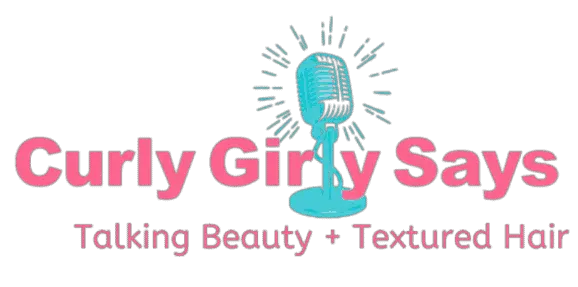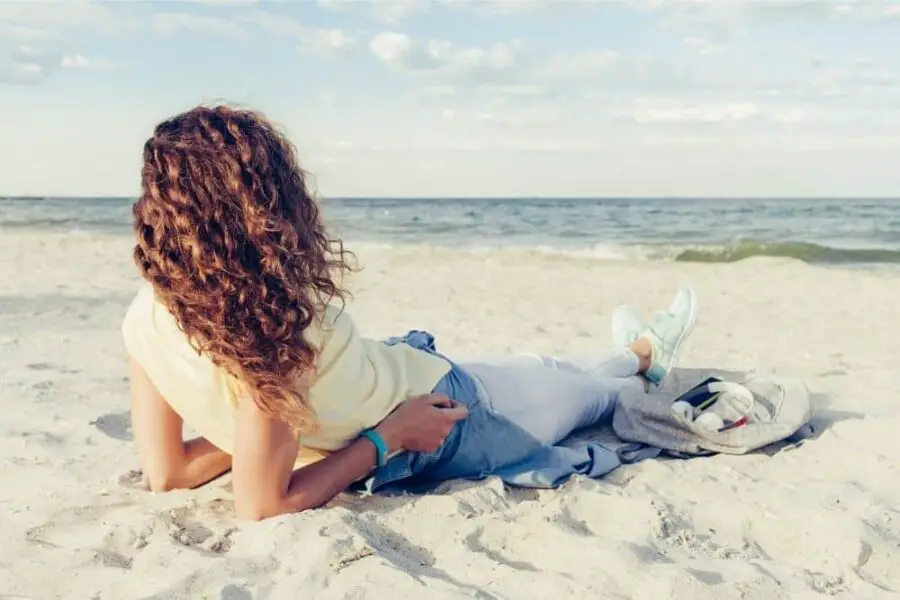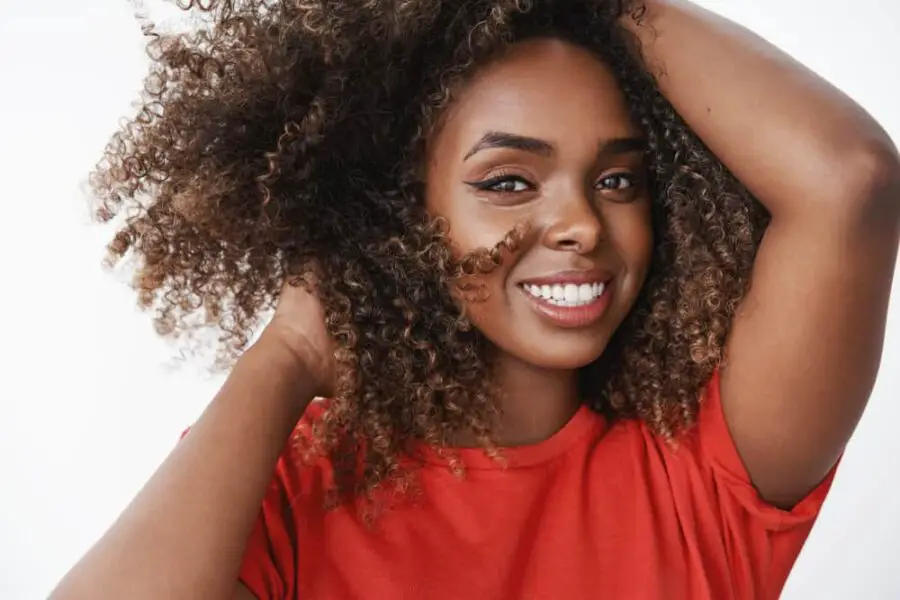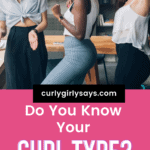Last Updated on July 3, 2025 by Doris Jean
To know how to care for curly hair, you have to know your type of curly hair.
Not knowing the type of curly hair that you have could be one of the reasons why your curly hair is not flourishing and growing as fast as you’d like.

So today, I’m going to break down every single thing that you need to know about caring for your hair which includes:
- types of curly hair
- how to care for your curly hair type
- how to bleach curly hair and still maintain your curls and
- products that you can use to care for your hair
In short, if you want to learn about the type of curly hair that you have so that you can maintain your hair and help your curly hair grow, this is the guide for you.
So let’s get started.
1. Types of Curly Hair
Where Did The Curly Hair Type System Come From?
The hair type system was actually created by Andre Walker. Andre Walker was Oprah Winfrey’s hairstylist and he created the hair type system that helps people today to be able to identify the types of hair that they have.
This system was invented in the 1980s and has since been adopted throughout the entire world to help people like yourself and me identify the types of curly hair that we have.
Though this hair system covers every single type of hair, the classification also involves curly hair.
And so you will find that the entire hair system that Andre created starts from 1A but curly hair actually starts from 2A.
Speaking of which let’s talk about the different types of curly hair and how you can identify your type.

How to Identify your Type of Curly Hair
According to the system that Andrea created, the different types of hair are categorized in numbers. So each number represents a specific texture.
In this case, type 2 is wavy, type 3 is curly, and type 4 is kinky.
So if you’re looking to identify the type of curly hair that you have, the first thing you should look at is the texture of your hair.
When you look at your hair, what type of texture do you see? Is it is it kinky? Is it wavy? Or is it curly?
Once you’ve identified the texture of your curly hair, now, it’s time to find out the exact category of your hair. And that’s where the letters come in.
The letters simply show the intensity of your hair texture.
For example, if your hair is wavy that means you have type 2 curly hair. If your hair is wavy with loose curls that make an S shape, then that means that your hair is type 2A curly hair.
Here is a simple table that shows all the curly hair categories including pictures to be able to easily identify your curl type.
Share this to your Favorite Pinterest Board!

How To Identify Your Curl Type If You Have Straightened Your Hair
If you happened to straighten your hair, you will not be able to get the actual texture of your hair.
And if that’s the case, the best thing you can do to find out your curl type is to wash your hair. Your hair falls back into its natural state when you wash it.
What if you have relaxed your hair?
If your hair is relaxed, then you can always wait for your hair to grow out and then find out the texture of your hair especially if you’re starting out with the curly girl method.
What To Do If You Have Different Types of Curls on Your Head
A lot of people have different types of curls on their head and it’s normal. If you find yourself in such a situation and you want to be able to identify the type of curly hair that you have here’s exactly what you can do step by step.
Step 1: Pick out the the hair that is in the middle of your head.
Step 2: Identify your curl type by using the chart above.
Step 3: What you find is the curly hair type that you have.
Disclaimer: This only applies to specific people who only have a small portion of their hair as a different curl type (e.g., only the outline of their hair is a different texture)
If you happen to have different types of curly hair in huge or equal proportions, here’s exactly what to do:
Step 1: Pick out the hair in the middle of your head and identify the type of texture that you have on that particular section of your head.
Step 2: Pick out the hair that is different from the middle of your head and identify the type of texture that you have in that particular section of your head.
Step 3: Once you’ve identified both textures, it’s time to create two different routines for each texture that you have.
Knowing that you have two types of textures on your head is a good thing because now you are able to cater to both types of textures.
It will obviously take a little bit more effort than having one type of texture on your head but if you do not take care of both textures of your hair, you’re going to have uneven curls.
Ad: Best Eyeliners
2. How to Care for Curly Hair
What is the best way to care for naturally curly hair?
Taking care of curly hair is not difficult. It actually involves three main aspects that you can do to have your hair naturally growing and glowing.
When you speak of curly hair maintenance, you think moisture, washing, and styling.
Moisture ensures your hair does not get brittle or break.
Washing ensures that your hair is clean and your hair doesn’t feel greasy and gross. It essentially helps your hair remain fresh and smelling great.
Styling helps your hair remain protected from the external factors that will make it dry out like weather. And if you happen to choose the wrong type of styling then your hair will end up weakening or breaking. In short, you have to be very careful with how you choose to style your curly hair.
How To Keep Moisture In Your Curls
Curly hair that is moisturized is less prone to shrink, break, frizz or tangle. The more your hair is moist, the more likely it is to grow and the less moist it is, the opposite happens.
So how do you keep your curls moist?
Water, Water & Water
I know this is a common, well-known way to keep your hair moist, but it is quite essential. Dry curly hair easily gets tangled. In fact, it is one of the major reasons for hair shedding.
So one of the easiest ways you can moisturize and prevent unnecessary shedding of your hair is to use water and use products with water at the top of their ingredient list.
Use Protective Hairstyles to Lock Moisture in your Curly Hair
Just as the name suggests, protective hairstyles protect your hair from the external environment or from manipulation. When I say manipulation, I mean combing it out.
It doesn’t have to be a hairstyle that literally covers your hair like braids. It could also be in the form of holding your hair in a bun just to retain that moisture within your hair.
Avoid Washing Your Hair Everyday
I know that sounds counterproductive, but if you do wash your curly hair daily you are taking moisture away from your hair.
If you feel the need to wash your hair every day, you can use a dry shampoo. Dry shampoos will refresh your hair. And not only that, but it will also make your hair smell great. So if your hair feels greasy, dry shampoo will come to your rescue.
Avoid Heat
Using heat on your curly hair is not bad. In fact, straightening your hair once in a while can help you create a different look. The only problem comes when you overdo it.
But if you can completely avoid heat, it would be the best thing.
Why? Because every single time you flat iron your hair, you are stripping the cuticle (outer protective layer of your hair) and leaving the cortex exposed. And what that does is it leaves your hair vulnerable to breakage meaning it loses moisture and ends up frizzing.
If you have to use your curling wands and your flat irons, use them in a low heat setting. That way, you ensure that you are not burning your hair or highly weakening your cuticle.
But I would strongly advise going on a no-heat campaign and you will see great results.
And if you want to create curls in your hair, you don’t have to do it with curling wands. You can do it naturally by braiding or plopping your hair throughout the night and then in the morning you are going to wake up to naturally curled hair.
Types of Products To Use To Lock Moisture In Your Hair
There are types of products that actually strip away the moisture of your hair and end up making your hair feel dry. In most cases that happens when you are using products that are not for your type of hair or contain specific ingredients like sulfates.
If that’s the case and you’re using a particular product that is making your hair feel dry then just simply stop using it.
We are going to go through the type of products that you can use on your curly hair that actually promote growth and lock moisture in your hair.
So scroll down to the very bottom if you are looking for the type of product that will help you grow your curly hair and lock in moisture.
Related Topics:
10 Best Products For Curly Hair
8 tips to Get Shiny Natural Hair
Is Coconut oil Good for Curly Hair
What are some tips for maintaining curly hair?
There’s a huge misconception that maintaining bouncy curls especially on curly hair is extremely hard, but that couldn’t be anywhere closer to the truth.
And so here are some of the easiest ways to maintain your bouncy curls.
Sleep With A Satin Wrap
If you have curly hair, then you know your hair gets tangled super easily and you end up losing your curls at night, but you don’t have to go through that anymore.
Satin wraps help to retain moisture in your hair. But that’s not the only thing that they do, they also keep curls in place.
So if you have natural curls or you’ve created your curls by plopping or braiding your hair, you can easily keep your curls intact by tying a satin wrap around your hair when you sleep. And in the morning, you’ll still have your curls.
Use A Satin Pillowcase
If the satin wraps don’t stay on your head like mine, your hair will be under stress especially because you’re rubbing your hair on your pillowcase as you turn throughout the night. And if you do that continuously, that causes your hair to break.
Also, cotton pillowcases tend to absorb the oil in your hair so you wake up in the morning with extremely dry and tangled hair with no curls.
On the other hand, satin pillowcases are soft, do not tangle your hair and neither do they absorb oil from your hair. Instead, they help your hair retain the moisture.
Secure Your Curls With Pins
The less your curls rub on each other, the better it is for curl maintenance. And the best way to keep your curls from rubbing on each other is holding your curls with bobby pins away from the sides of your head. You could either braid your hair and secure them with bobby pins or you could just use the bobby pins.
The reason to keep your curls away from the side of your hair is to ensure you do not lie on your curls as you turn at night.
Create A Washing Routine for Your Curly Hair
In order to maintain your curly hair, you need to create a washing routine that works for your hair. Here are simple washing routines for each type of hair so that you can follow along.
Washing routine for 2A, 2B & 2C
Washing routine for 3A, 3B & 3C
Washing routine for 4A, 4B & 4C
3. How To Bleach Curly Hair
Does bleaching curly hair damage it?
Bleaching dries out curly hair so you have to take extra care of it because curly hair is naturally dry and bleaching only makes it dryer.
So in this section, we will go through each hair type, what to do before you bleach your hair and what to do after to maintain your curls.
How To Bleach Curly Hair At Home
Bleaching your hair at home can be cheap and save you some coins but if you’re new to bleaching, it’s best if you consult a hair specialist. But if you want to do it at home, here are the steps to follow:
1. Prep your hair and scalp by adding a deep conditioning mask and coconut oil.
2. Separate your hair into 4 parts and hold the parts in place with hair clips.
3. Depending on your lightener, add 2 scoops of it in a mixing bowl/ read the label.
Normally, all lighteners have the instructions on the label on the amount of lightener you should use.
4. Then mix in your developer with a wooden stick or the brush you’ll use to apply the mixture.
You could use the 40 volume developer especially if you have dark hair. You’ll get the best results with the 40 developer. But again, it’s always good to consult with a professional.
5. Finally, add in your bond treatment to the mixture and mix well.
You could use Olaplex treatment or Loreal’s Smartbond.
6. When applying the mixture, you could do it in two ways.
You could either apply it by taking small sections of hair and using foil paper or you could just use the brush and section out your hair into little sections and apply the mixture without using the foil paper.
7. Once you’ve applied the mixture to your entire head, let the dye sit in for 25 – 30 minutes depending on the intensity of the color that you want.
In case you wash out the dye before you achieve the color that you want, don’t redo the whole process. Let your hair rest and redo the process after a week or two.
8. Wash off the dye thoroughly.
Make sure you wash the product completely otherwise it will continue processing your hair and that could lead to massive hair loss.
9. Tone your hair after you wash off the dye.
Use your hair toner throughout your hair. Toning helps with evening of the color of your hair.
10. Deep condition your hair and let it rest.
See down below what you should do before and after you bleach your curly hair.
Bleaching Type 2 Curly Hair
What To Do Before Bleaching Type 2 Hair
Use Olaplex treatment products to protect your hair from massive damage before, during, and after bleaching your hair.
Olaplex treatment is a basic 3-step process that protects the hair from being damaged by harsh chemicals like hair bleaching products.
What to do After Bleaching Type 2 Hair
- Use a lightweight styling serum for moisture retention.
- Use products with UV protection. (See the list in the product section below) especially if you have dyed your hair blond and grey.
- Use bond treatments like Olaplex, smartbond, karaal baco powder after bleaching.
And if you happen to use Olaplex treatment before bleaching, it’s best advised to use a different bond treatment afterward because each has a different composition of ingredients that the hair needs to remain healthy and strong.
So you need to change things up every now and then.
That is why it’s good practice to mix things up each time you have these types of treatments done.
- Because bleaching can alter the texture of your curls, use deep moisturizing treatments to ensure you restore your curl texture.
Bleaching Type 3 Hair
What to do Before Bleaching Type 3 Hair
Because type 3 and type 4 hair are more prone to dryness than type 2 hair, you need to take extra steps before bleaching your hair. Anything that can cause your hair to dry out before you bleach your hair, you must not do it.
- That means that you cannot use heat directly on your hair a week before you start bleaching your hair.
- You must do a deep moisturizing treatment for your hair 3 days prior to bleaching your hair. That will help your hair hold in moisture even after being bleached and that helps to prevent brittle hair that eventually breaks.
- Also, consider doing a deep conditioning treatment that includes a mixture of different oils and conditioners on your hair 3 days prior to bleaching your hair.
The stylist, Ashley, at JC Penney recommends the Genedor Beauty Moisture Resuscitate Conditioner to help create a barrier against the harsh chemical.
- Use a hair mask a day prior to bleaching your hair. It helps to lock in the moisture.
What to do After Bleaching Type 3 Hair
- Use a detangling comb (See the list in the product section).
- Use a moisturizing shampoo (See the list in the product section).
- To lock in the moisture, always remember to cover your hair to avoid the hair rubbing on your pillow case.
Bleaching Type 4 Hair
What to Do Before Bleaching Type 4 Hair
Do not be mistaken type 4 hair babies. Type 4 hair is extremely dry and easily prone to breaking.
Not only because of the curls but also because of the way the hair follicles grow out of the scalp in a circular motion. And that affects the way the sebum reaches the ends of the roots of the hair.
So that type of growth pattern makes the type 4 hair extremely dry even before bleaching.
That’s why you need to ensure that you’re taking extra effort to moisturize your hair before you bleach. And how are you going to be able to do that?
- By performing a hot oil treatment.
Hot Oil treatments are actually a combination of different oils that are heated and used to moisturize your hair. You can pick different types of oils that you want to use on your hair and combine them.
Once you identify the types of oil that you want to use on your hair, all you have to do is put the oil in a bowl and into a microwave.
Once you heat the oil, apply throughout your hair starting from the ends to the roots.
Note: Before applying the oil to your scalp ensure it’s not too hot by doing a test on the back of your hand. You don’t want to burn your scalp.
What to Do After Bleaching Type 4 Hair
- Use a detangler and avoid using regular combs as they will break your hair.
- Use Mist Nourishing water to lock in moisture.
- Use a sulphate free shampoo.
Quick and General Rules to Follow When Bleaching Curly Hair
- Do not try to go blonde in one salon session.
- Ensure you tone your hair after bleaching your hair.
- Regardless of which type of curly hair that you have, always use a bond or an Olaplex treatment before or after bleaching your hair.
- And finally, moisturizer, moisturize, moisturize.
- Do not double process your ends after you redo your roots. That will only make your ends weak.
What Not to Do Before Bleaching Curly Hair
DO NOT expose your hair to heat.
Do NOT wash your hair.
Applying dye to a clean scalp is going to be a lot more painful than when you leave your hair a lot greasy and filled with oils and products you’ve been using throughout the week. What that does is create a protective layer on your scalp and hair follicles.
So the next time you’re going to book an appointment to change the color of your hair, make sure your hair hasn’t been washed for a week.
4. Products For Hair Care by Curly Hair Type
Best Products for Type 2 Hair
Best Products for Type 3 Hair
Best Products for Type 4 Hair
Best Products to Protect Curly Hair
I hope you found this article useful! Let me know in the comments.
























Leave a Comment